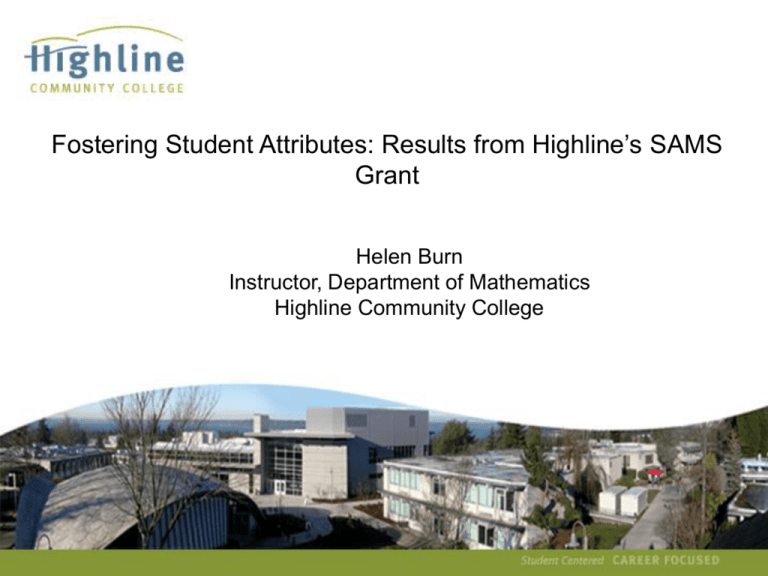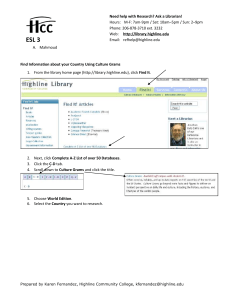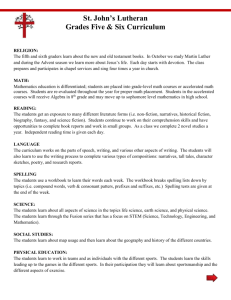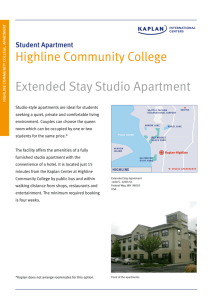PowerPoint - Curriculum Research Group
advertisement

Fostering Student Attributes: Results from Highline’s SAMS Helen Burn Grant hburn@highline.edu Helen Burn Instructor, Department of Mathematics Highline Community College Goals of this Session •Share evaluation results that show how FT faculty at Highline are teaching the attributes: surveys/interviews, tasks. •Hear your reactions and ideas •Share “deep thoughts” about student attributes: What are they, really? Do our “categories” work? Will they ever become institutionalized? SAMS: Student Attributes for Math Success Grant goals: Departmental curriculum groups (Dev Math, Gen Ed Math [GEM], and STEM) have worked to embed student attributes into courses through including the attributes in course learning objectives and through developing specific tasks that address student attributes. The student attributes are part of our departmental “climate.” •SAs used to frame Achieving the Dream mentoring program (2006) •SA learning outcomes included in all dev ed and some GEM and STEM courses (2009) •Survey results suggest faculty are thinking hard about SA’s Learning Outcomes Examples •Math 81: Introduction to Algebra Describe her/his reasoning on a task, including sources of confusion or errors [Pays attention to detail, Takes responsibility for own learning] •Math 91: Essentials of Intermediate Algebra Describe her/his level of understanding before a formal assessment as well as steps she/he will take to improve [Demonstrates intellectual engagement, Takes responsibility for own learning] Learning Outcomes Examples •Math& 146: Introduction to Statistics Examine and evaluate a statistical process and its results including recognizing when arguments are valid and invalid based on how data was collected and statistical processes used. [Persevere through timeconsuming tasks] Survey Results (n=10) •Survey Monkey, Winter 2010 •10/13 (77 percent) FT response rate •No usable PT surveys •Some follow-up interviews/discussions Precollege College DEV (n=4) 2 4 GEM (n=2) 1 2 STEM (n=3) 1 3 No CG (n=2) 1 1 Survey Results (n=10) Agree Strongly Agree I am aware of the SA section 4 of the College Readiness (all STEM) Standards 6 I am doing more now than in the past in terms of incorporating the SA’s into my teaching 1 8 (all DEV, all GEM) Conclusion: There is still room to grow More awareness in DEV and GEM Survey Results (n=9) The SA’s have been discussed at some point in my curriculum group Agree Strongly Agree 2 7 (STEM)* (all DEV, all GEM) *One STEM disagreed If you agreed, briefly explain what led to the discussion of the attributes in your group: Formal structures (n=5): New course, CAF, AtD Personal interest (n=2) Taught in the past (n=2) Conversations with interested colleagues (n=3) Survey Results (n=9) What do you feel you are doing differently now than in the past regarding implementing and discussing attributes? How have you changed, if at all? (n=9) Mentioned a specific new task (n=6) Has been increasing/thinking more about SA (n=5) Wants to do more and/or better in the future (n=3) I am more aware of how each class activity contributes to the attributes. I do group quizzes and homework presentations. Intellectual Engagement (n=9) Perceives mathematics as a way of understanding… (n=6) Actively explores new ideas, posing questions, .. . . (n=4) Recognizes patterns . . . (n=7) Appreciates abstraction and generalization. . . (n=3) Is willing to take risks and be challenged . . . (n=6) Contributes and benefits from group problem solving (n=7) TASKS mentioned: A natural part of their teaching (n=7) Gives harder problems, typically in groups (n=5) Group work (n=7) “Harder Problem” Examples • Factor by grouping 96 176 84 154 2 3 2 2 3 2 • Graph the triangle with vertices (-2, 1), (-6, -8), (-11, 5). Show that this is a right triangle. “Taking Risks” Examples • Assign students numbers and choose them at random to show homework on the board. Or have students volunteer. • Make student work public using ELMO technology • Use open-ended tasks that ask students to engage in a concept without prior instruction. Takes Responsibility for Learning (n=7) Attends nearly every class session . . . (n=5) Conscientiously prepares work assigned for class (n=3) Examines and learns from errors, seeks help . . . (n=5) Takes advantage of resources. . . (n=6) Sets aside necessary time . . . (n=4) TASKS mentioned (n=8): Speaks to it (n=5) Encourages attendance (n=3): Board presentations, attendance in grade, quiz at beginning of class Takes Responsibility for Learning TASKS mentioned (n=8): Encourage preparation (n=5): Prereading assignment, reading guides, provide daily schedule, group quizzes, boardwork Creates online resources and expects engagement (n=4): Post notes online, web-based videos, homework, Angel postings Examines and learns from errors (n=5): Collect HW and expect students to review; provide key to exams, board presentations, error analysis/partial credit request, retesting scheme, students grading each others’ quizzes Example Tasks • Frequent quizzes at the beginning of the class. Tardy students do not have additional time. . . [Encourages attendance] • Provide detailed answers for each test. If class does poorly on test, an announced make-up quiz will be given within a week that consists of two or more randomly selected questions similar to the test. If student obtains full points on the make-up, half the difference is added to the original score [Takes responsibility, learns from errors] • Partial credit requests on exams Perseveres Through Time Consuming Tasks (n=8) Willing to work on challenging problems (n=7) Successfully completes complex, multi-step tasks (n=5) Recognizes unproductive approach (n=3) Is convinced that efforts is important to success (n=4) TASKS mentioned (n=8) Projects (n=3), only in stats and Math 95 More advanced problems, critical thinking problems (n=5) Speak to importance of effort. Stressed in class or through Dweck video (n=2) Pays Attention to Detail (n=4) Correctly follows all parts of oral and written directions without needing additional reminders (n=3) Makes few notational errors . . . (n=3) TASKS mentioned (n=3) Points out common errors; uses metacognitive language (n=2) Expects details in answers or points deducted (n=1) Just expects it Example Tasks I require calculus students to “write the answer (to a word problem) in a complete sentence, including units. “Be precise in the inclusion or exclusion of the descriptor ‘limit as x approaches a.” . . . Points will be deducted if the details are omitted. The Future of Student Attributes? As written, they are murky. The “categories” are not clear, nor is their theoretical rationale. • • • • Metacognition Study Skills Habits of Mind College Knowledge At Highline, we recognize that effective teaching requires that we build SA systematically, rather than haphazardly, into our teaching. Weekly Checklist (Diana Lee a la Atul Gawande) WEEK ONE • First Day - Review Syllabus, show logging into MML, introduction to a notebook organization system • Midweek – Taking Personal Responsibility (before, during, after class) • Midweek – Have students bring notebooks and tabs and set them up • End of Week – Review again Personal Responsibility (before, during, after class) and review logging into MML . . . WEEK THREE • Monday (during exam) do a notebook check (organization, inclusion, forms filled out) • Day after exam – Student fill out self-reflection (concepts understood and study effectiveness) • End of week – Time management (what does it mean to study effectively?) Adding it Up, NRC (2001) • • • • Conceptual understanding Procedural Fluency Strategic Competence Adaptive Reasoning: (Capacity for logical thought, reflection, explanation, and justification) • Productive Disposition (Habitual inclination to see mathematics as sensible, useful, and worthwhile, coupled with a belief in diligence and one's own efficacy How Students Learn: Mathematics in the Classroom, NRC (2005). Principle 1: Teachers Must Engage Students’ Preconceptions Principle 2: Understanding Requires Factual Knowledge and Conceptual Frameworks Principle 3: A Metacognitive Approach Enables Student Self-Monitoring. • Emphasis on debugging problems • Internal and External Dialogue as Support for Metacognition • Seeking and Giving Help Carnegie Foundation (2009) Psychosocial Theories to Inform a New Generation of Student Support Structures for Learning Mathematics, Fong & Asera (2010) http://www.carnegiefoundation.org/sites/default/files/elibrary/psychosocial_theories.pdf “The goal of this paper is to explore theories from psychology that could inform a new generation of student support committed to increasing student motivation and academic success” (p. 2) • • • • • Bandura’s Theory of Self-Efficacy Motivational Processes (Goal Orientation, Self-Regulation) The Social Environment (Stereotype Threat) Grit, Resilience, and Self-Discipline Theory to Practice: AYD The Students and Professors Misunderstand One Another College Fear Factor: How Students and Faculty Misundersatnd One Another. Cox (2009) • • • • Imposter Syndrome Advising Needs College Cultural Capital (Bourdieu) College Expectations Redefining College Readiness (Conley, 2007) http://www.aypf.org/documents/RedefiningCollegeReadiness.pdf • Key Cognitive Strategies (open mindedness, analysis, reasoning, etc) • Academic Knowledge and Skills (writing, research, core academics) • Academic Behaviors (study skills, self monitoring) • Contextual Skills and Awareness (advising, resources, etc.) My Framing of Student Attributes • Understands college norms and values (intellectual engagement, taking responsibility for learning, actively exploring questions, taking risks, complexity) • Prerequisite Knowledge and Skills (writing, research, core academics) • Metacognitive Skills (self monitoring, self regulation, attn to detail) • Campus navigation skills (registration/advising, how to approach faculty, netiquette skills, available resources, etc.) Helen Burn Highline Community College Curriculum Research Group hburn@highline.edu www.CurriculumResearchGroup.org







